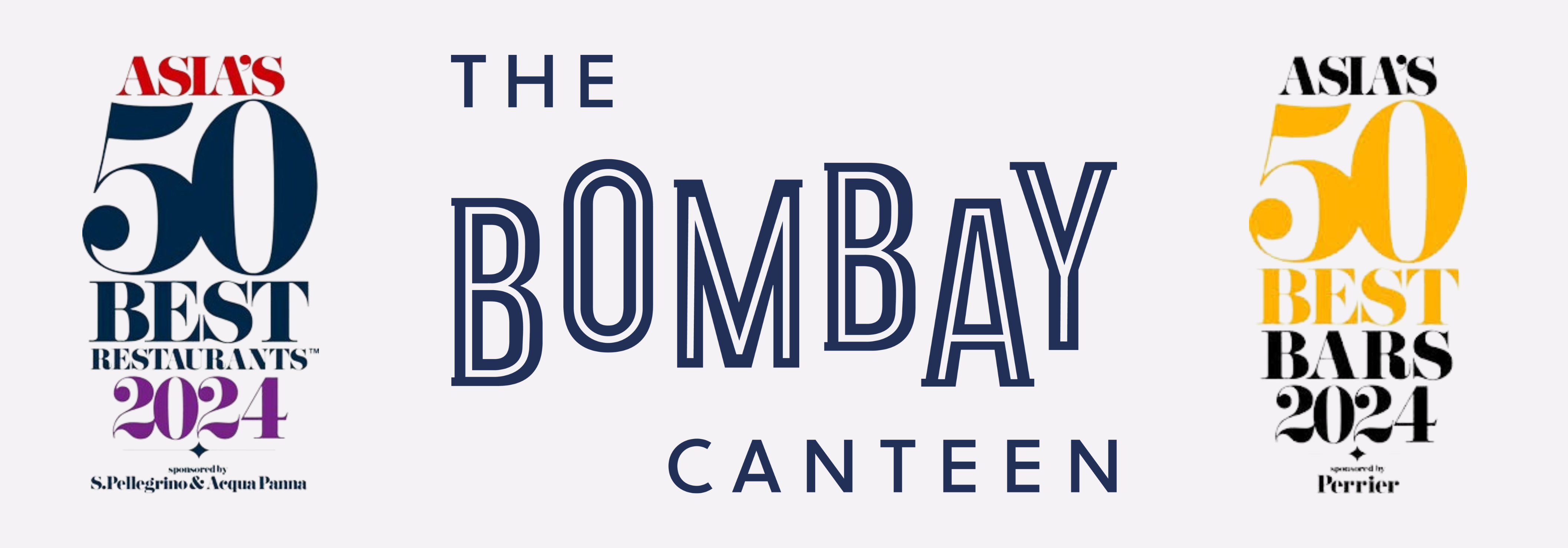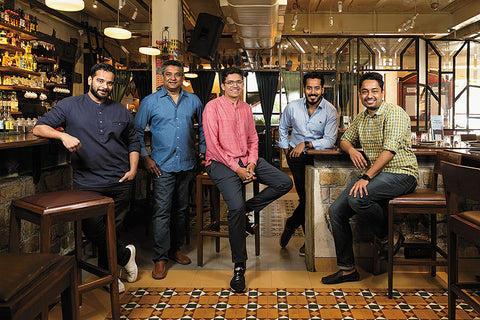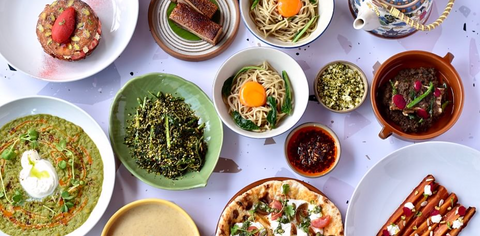UPDATE: Since the publishing of this piece, The Bombay Canteen has announced that Chef Thomas Zacharias will be stepping away from every day operations at the restaurant, and handing the reins over to Chef Hussain Shahzad, to pursue 'new avenues' and 'personal interests in the culinary space'. He will continue to be a shareholder in Hunger Inc
***
It’s a cooking class with a twist (or several).
A lockdown project by Chef Thomas Zacharias of The Bombay Canteen, the ‘Cooking with TZac’ series on Instagram has no starched white coats or sanitised visuals. Each 10 to 15 minute video, self-shot in the chef’s home kitchen, pops with colour—he shows off Hawaiian shirts, coloured shorts, funky dance moves and a bright rainbow of ingredients. Best of all, a hilarious running commentary pokes fun at him through the video, captioned by a certain advertising executive who goes by the name Sicily Chechi. So, while you’re learning to whip up traditional Chettinad Vendakkai Mandi or Himachali Chana Madra, you’re likely grinning your way through it.
The video series is perhaps an indicative microcosm of what Hunger Inc, the parent company behind The Bombay Canteen (regional Indian), O Pedro (Goan-inspired) and Bombay Sweet Shop (modern take on Indian mithai), in Mumbai, stands for. The philosophy across all three restaurant brands—on the bucket list of most gastronomes across the country—and the company as a whole, is to support and celebrate Indian regional cuisine, the kind you associate with your grandmothers or hometowns, as oO Pedro’s executive chef Hussain Shahzad hosted a Goan Poee-making workshop over Zoom during the Covid-19 lockdown that was sold out within two days of its launchpposed to that served at a Moti Mahal or an Udipi.
“Around 2012, what we were seeing was that local and comfort food was again being made cool across the world. Indian food, however, was still either being eaten at home, or at restaurants serving North Indian and South Indian food, but nothing in between,” Sameer Seth, co-founder, Hunger Inc, says. “Our theory was that we all go back to flavours we grew up with. Chef Floyd Cardoz was my boss at the time [in New York City], and he thought the idea made sense too.”
And so, Hunger Inc took shape with founders Sameer Seth and his Cornell University classmate Yash Bhanage, who was working at a luxury resort in Singapore at the time, along with globally celebrated chef Cardoz as co-founder and mentor. While Seth and Bhanage both moved back to Mumbai, Cardoz shuttled between the US and India, leaving the daily operations to the duo. They raised about ₹1 crore from friends and family in funding; even today, the team doesn’t look at institutional funding, but from individual partners who they believe can add value strategically.
This March, around the time they turned five, the team suffered a giant shock: Chef Cardoz, after a successful trip to India to launch the Bombay Sweet Shop, was diagnosed with Covid-19 upon his return to the US, and died on March 25. [Forbes India had met with him in Mumbai a few days before his return, to talk about Hunger Inc hitting the five-year milestone, and the newly launched Bombay Sweet Shop. The quotes used in this story are from those interactions.]

opedro O Pedro’s executive chef Hussain Shahzad hosted a Goan Poee-making workshop over Zoom during the Covid-19 lockdown that was sold out within two days of its launch
Image: Courtesy O Pedro
Hit both professionally and personally by Covid-19, the team has had to tide over a rough 2020. “Losing Chef Floyd is a huge setback that I don’t think we’ll ever get over,” Seth tells Forbes India. “But at this point, we have to focus on bringing some stability to the team and the business, and then hopefully, take the space out to deal with losing someone so close, a father figure to us.”
At the time of writing, some restrictions have been eased in Maharashtra’s lockdown, and O Pedro, in Mumbai’s Bandra-Kurla Complex, has opened to diners at 50 percent capacity and with a new outdoor seating option. Bombay Sweet Shop, which launched its sunlit, Willy Wonka-esque space in Byculla just a few weeks before the lockdown, is open for takeaway. The Bombay Canteen is now readying to reopen, with the idea of showcasing local art on the tables left empty for social distancing. All three brands have been running delivery operations through lockdown, but the team had to think out of the (Swiggy) box to keep themselves going.
*****
The Hunger Inc chefs—Zacharias and Hussain Shahzad (O Pedro) in particular—have built a reputation for being torchbearers of sorts for regional, sustainable Indian food, but with a contemporary, trendy approach. So, winter’s hara chana, found along the streets of North India as spiced chaat, dons a mousse avatar; the Gujarati methi thepla becomes the base for a vindaloo taco, and so on. The flavours are complex, but the dishes are served in simple, straightforward plating, without the smoke and mirrors (or liquid nitrogen) that’s become the overt tone of ‘modern Indian’ food over the past decade.
cheduputtu village Hunger Inc and the Naandi Foundation have joined hands to improve sustainable practices among farmers in Cheduputtu, a village in Araku Valley, Andhra Pradesh
Image: Courtesy Hunger Inc
This is well in line with chef Cardoz’s own cooking philosophy, cultivated over the years at his US restaurants, including the pioneering Tabla, which ran for nearly two decades in a cut-throat New York market before it shuttered in 2010.
“One of the important moments for me in my career was when I opened Tabla, and [acclaimed American chef] Alice Waters came in. I told her how chefs in California, like her, are so lucky because they have all these great ingredients to work with,” Cardoz told Forbes India. “She turned to me and said, New York has the best potatoes and apples. Learn to cook with them, and the day you do, you become a great chef. That’s been my philosophy since.”
hunger inc
Cardoz and the rest of the Hunger Inc team place great premium on the discovery and innovative use of rich regional ingredients. “Everyone uses Italian lemons but they ignore the beautiful gondhoraj lemon, which even I hadn’t heard of until a couple of years ago. So, looking at that whole spectrum of what’s available and how we can use it is a pretty cool process. We get to show people that this is who we are, and this is what we believe in,” Cardoz added.
Funnily, neither Zacharias nor Shahzad had any experience in cooking Indian food before they joined Hunger Inc. Both had worked at top restaurants in New York, and then in India in mostly European cuisine. “It’s a good thing we didn’t have Indian restaurant experience, because cooking in those kitchens is nothing like what we cook at home,” Zacharias says. “Instead, we came from a point of humility because we knew we didn’t know anything and were eager to learn.”
Zacharias says the timing was serendipitous for him. “I had just had this epiphany on a trip to Europe, and walked out of [top chef] Massimo Bottura’s restaurant feeling extremely restless, thinking my work didn’t have a larger purpose,” he recalls. “So when I met Sameer through a headhunter, and he explained the concept to me, I was sold in five minutes.”
For both chefs, a whole lot of research goes into building their menus. “I realised how little I knew about Indian food—and still do,” says Zacharias. “That’s why I decided to travel the country.”
On Zacharias’s first trip, he visited 18 or 19 places over two months, and garnered techniques, flavours, stories from each. “These were things that were definitely not being represented at Indian restaurants,” he says. Since that inaugural trip, his ‘Chef on the Road’ travels across India, from Odisha to Kashmir to the interiors of Maharashtra, have acquired a hashtag and great social media interest.
yash bhanage and cheduputtu villagersCo-founder Yash Bhanage (left) and team works closely with villagers in Cheduputtu, Andhra Pradesh, to ensure donations achieve maximum impact on the ground
For Shahzad, who admittedly knew little about the rich diversity of Goan food, months spent in the sunshine state were an eye-opener. He visited people’s homes and learnt techniques and recipes from their kitchens, including a repertoire of vegetarian cuisine from the Goan Saraswat Brahmin community. The making of O Pedro’s popular poee, which comes served with balchao or choriz butter, however, came with an interesting experience for the chef.
Shahzad worked with a baker who started at 3 am, didn’t measure anything, and took siestas in between. While he learnt the fundamentals from watching the baker at work, it took him several attempts to finally nail a recipe that would go on the menu—an innovative sourdough poee, that remains one of O Pedro’s signature menu items.
“Floyd created a very, very good team, and gave them a lot of rope to do things their way, because he knew they understood his vision,” says Kurush Dalal, culinary expert and food anthropologist. “These are the few chef-driven restaurants in India, which is something Floyd brought in, as opposed to owner-driven restaurants where chefs don’t have much freedom.”
“I remember eating sarson ka saag at The Bombay Canteen, and till that point, my experience with that dish was traditional—beautiful but often overcooked, maybe a little clumsy,” says celebrity chef and TV anchor Gary Mehigan. “In this one, Thomas used jaggery like a toffee, he had popcorn, corn bread, and I thought, yeah… that’s how you give a dish a clever little push in a different direction.”
gary mehganImage: Graham Denholm / Getty Images
“He’s done that with many of the dishes,” Mehigan adds. “I remember eating haleem, which up to that point was big and heavy even though it was delicious. Thomas’s was much lighter even though he cooked it for a long time and got the flavour on point.”
“Yes, there’s the shock value of using produce no one has heard of, like kankrol (spiny gourd) for instance. But it’s also about doing things differently,” says Dalal. “For instance, Mumbai had a trend of nose-to-tail dinners that mainly used the pig, but at Hunger Inc, they decided to do it with the goat. And this wasn’t the usual rogan josh or a kosha mangsho, but a mousse with the brain, a dessert of shahi tukda with goat milk jam and goat’s cheese semifreddo. This is how you take people’s jaded taste buds and wake them up, and garner respect from diners as well as the chef community.”
It’s this reputation, and what Seth refers to as the ‘cycle of curiosity’ at Hunger Inc, that led them to a series of innovations during the Covid-19 lockdown. Before starting up their kitchens for delivery, the company launched a bunch of digital experiences. You could take Zoom class on poee making or Goan/Portuguese food with Shahzad or learn one of Zacharias’s recipes from his travels. Or you could buy recipe books or the cheeky T-shirts the waiters are known to wear, or gift cards at a discount for when restaurants would eventually reopen.
What’s also held them in good stead is to turn the Bombay Sweet Shop experience into a product ecommerce play that can scale more easily. “What Covid-19 did was push us into the concept of achieving scale through more products, not physical stores,” says Tarun Joshi, a tech entrepreneur and investor in Hunger Inc. “With Bombay Sweet Shop, we now have scalability in terms of reach as well as distribution channels.”
Their biggest innovations, perhaps, came from the company’s larger purpose, to celebrate and support all things Indian, and educate along the way. Once every month, The Bombay Canteen would shut to customers on Saturday afternoons to turn into a classroom. “The idea came to me while ranting to a friend that when I go to speak at hospitality schools about entrepreneurship, they always begin with a list of things I can’t talk about,” says Bhanage. “It took me back to when I was seeking advice from a career counsellor.”
Bhanage, who was a good student and confused about which part of hospitality he should focus his skills on, got a befuddling response from the counsellor: ‘You’re tall, you should join the reception.’
So instead of going to schools to speak with students, Bhanage turned the model around, and invited students (and anyone else who would want to sign up) into their turf four years ago, to bridge the gap between academic and practical knowledge. When the restaurants closed for Covid-19, these ‘Canteen Class’ sessions moved to The Bombay Canteen’s Instagram once a week, covering everything from sourcing and innovative dining concepts to the future of farming and what it means to reopen a restaurant during a pandemic, featuring category experts from across the country, and some international names as well, including Mehigan.
The second big initiative is one of Hunger Inc’s biggest days of the year—the Independence Day Daawat. Over the years, on August 15, the team invites diners into The Bombay Canteen for a langar-style thali, serving cuisines from regions across India. Diners can pay what they like, to support a cause. For the initial years, this cause was of education, and since last year, Hunger Inc has partnered with the Naandi Foundation to adopt a village called Cheduputtu in Andhra Pradesh, located in the Araku valley. The foundation works to better farmer livelihoods and sustainable practices.
The first year of the daawat, the team served 170 people and raised ₹1.7 lakh; in 2019, they served almost 800 people to raise ₹24 lakh for the Naandi Foundation. “We want to make a long-term impact, and have signed a project on for six years,” says Seth. “In just a few months, we’ve learnt so much. Yash and the team have been on the ground seeing how the money is being applied, teaching the farmers about which crops would do well, and we are supporting them financially as they rebuild from scratch, and also buying back some of the produce they generate.”
“When I met them, I saw a certain authenticity about wanting to do something, and I took the liberty of going the full hog rather than tokenism, asking them to take up a project in the broad food space,” says Manoj Kumar, CEO, Naandi Foundation and co-founder, Araku coffee.
“The idea is whenever Hunger Inc serves food to customers, they can link it innovatively to larger issues of planet, farmer livelihood, nutrition, soil, grooming the next generation of farmers,” Kumar adds. “And this team is very committed to the cause and has put money where their mouth is.”
This year, of course, the restaurants were all shut. It took some brainstorming, but the team was determined to continue with the Daawat, even as they were struggling financially themselves. With eco-conscious design firm Corugami, this year, they reimagined the daawat for a lockdown setting. So instead of eating on a banana leaf at The Bombay Canteen, you would receive your own customised box, packed with all the thali items as well as information and instructions—and a banana leaf to unroll and eat off. “This year, around ₹15 to 16 lakh have been raised,” says Kumar.
What do the next five years look like for Hunger Inc? Chef Cardoz summed it up best, back in March:
“So here’s what I really want for the company: I want all three of our restaurants to do really well and continue to set the standard for what they’re doing. Number two is to continue that philosophy and adapt it to practices that are sustainable. Third, to have a platform to grow the team from within, the next generation. I know from cooking all these years that you can’t do everything yourself. The better people you grow, the more successful you’ll be in the long term.
I still want to set the bar in terms of the food we do, the service we have, the kind of hospitality we offer, and importantly, how we treat people. I want to be able to keep our chefs happy and in the company for a long time, but also give them the tools to succeed. In terms of expansion—I never build something to expand it. But I never say never. If destiny wants us to, we will.”
Originally published on forbes:




Comments (0)
There are no comments for this article. Be the first one to leave a message!